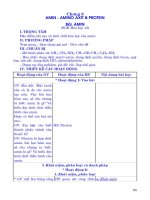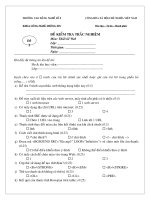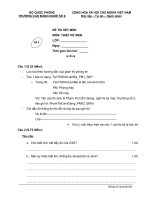Bài giảng Thiết kế tuabin pelton
Bạn đang xem bản rút gọn của tài liệu. Xem và tải ngay bản đầy đủ của tài liệu tại đây (618.72 KB, 28 trang )
Design of Pelton
turbines
When to use a Pelton
turbine
Energy conversion in a
Pelton turbine
Outlet
Outlet of
the runner
Inlet of
the runner
Outlet of
the needle
Inlet of
the needle
2
2
c
Main dimensions for the
Pelton runner
The ideal Pelton runner
Absolute velocity from nozzle:
n1
Hg2c
⋅⋅=
1
Hg2
c
c
n
1
1
=
⋅⋅
=
Circumferential speed:
n
u1
1
Hg2
2
1
2
c
u
⋅⋅⋅==
5.0u
1
=
Euler`s turbine equation:
)cucu(2
u22u11h
⋅−⋅=η
1)05,00.15,0(2)(2
2211
=⋅−⋅⋅=⋅−⋅⋅=
uuh
cucu
η
1c
u1
=
0c
2u
=
The real Pelton runner
• For a real Pelton runner there will always be losses.
We will therefore set the hydraulic efficiency to:
96.0
h
=η
The absolute velocity from the nozzle will be:
995.0c99.0
u1
<≤
C
1u
can be set to 1,0 when dimensioning the turbine.
This gives us:
)cucu(2
u22u11h
⋅−⋅=η
⇓
48,0
0,12
96,0
c2
u
u1
n
1
=
⋅
=
⋅
η
=
From continuity equation:
u1
2
s
c
4
d
zQ
⋅
⋅π
⋅=
⇓
u1
s
cz
Q4
d
⋅π⋅
⋅
=
Where:
Z = number of nozzles
Q = flow rate
C
1u
=
n
Hg2
⋅⋅
The size of the bucket
and number of nozzles
4.3
d
B
1.3
s
≥>
Rules of thumb:
B = 3,1 · d
s
1 nozzle
B = 3,2 · d
s
2 nozzles
B = 3,3 · d
s
4-5 nozzles
B > 3,3 · d
s
6 nozzles
Number of buckets
17
≥
z
empirical
Number of buckets









